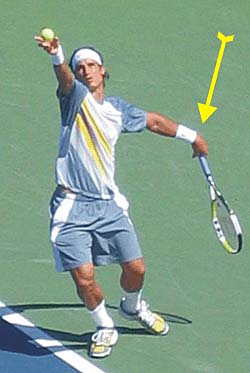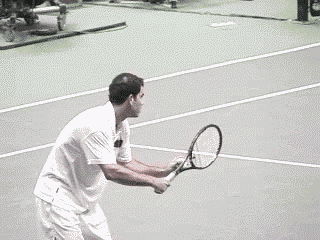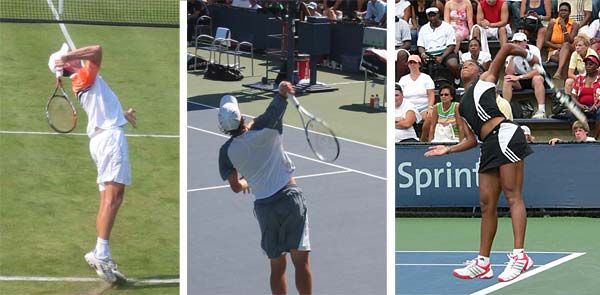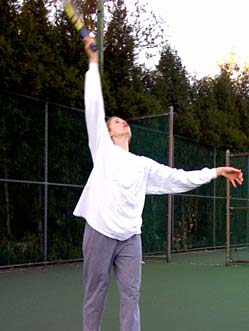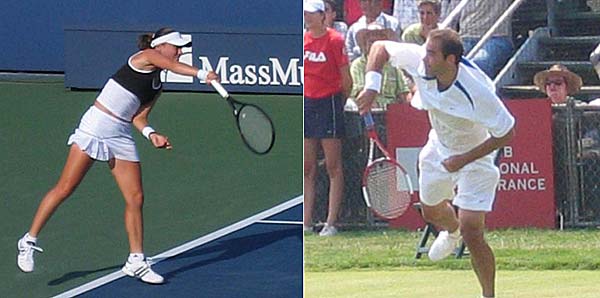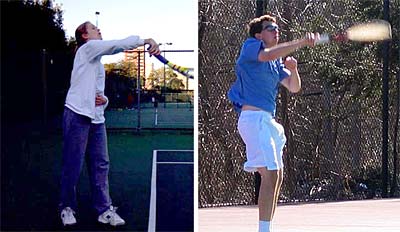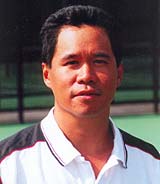|
TennisOne Lessons The Serve – Developing the Live Arm Doug Eng EdD, PhD In a previous article, I discussed developing leg action on the serve. In this second part, we will focus on developing arm action. In fact, let’s call this the live arm action. For some people, this action occurs naturally. Often coaches will look to a person’s natural ability to throw a ball as an indicator of how well the person might potentially serve. But what if you didn’t throw well -- might you potentially still have a good serve? The answer is yes, but it takes dedicated practice to develop.
If we are to define what makes a good serve, the live arm is a dominant criterion. A good live arm motion has several key elements:
Initial Relaxation Relaxation in tennis is critical to the smoothness of motion and the power behind the hit. In the pre-serve ritual, you incorporate relaxation, visualization, behavioral habit, and focus. Often we think of behavioral consistency -- such as bouncing the ball six times -- as important. For some players, a consistent ritual can be important as it helps create a focused mind set. But Novak Djokovic has a pre-serve ritual with varying behavior. The number of times he bounces the ball varies from point to point. If the match is not close, he tends to bounce less frequently. When the score gets close, he will bounce the ball as many as twenty times. So for many people, consistency itself is not essential. More important is confidence in the moment and relaxation before the serve. I use this phrase “confidence in the moment” to indicate confidence at the start of the service motion, as confidence often has ups and downs throughout a match. At any given moment, to be successful, you must be comfortable and confident.
At the start of the serve, you must feel very good about your serve and your ability to win the next point. If you need to bounce the ball a few more times to feel ready, then do so. Or, if you just had a long point, you may need more time to prepare. On a big point, you might be tight and also need extra time to prepare. When you are well ahead in a match, you feel more confident during those moments and tend to get into a faster-paced, comfortable ritual. When you feel relaxed and confident about the next point, it is much easier to serve well. Confidence and relaxation are related and are essential to maximizing the live arm. Any lack of confidence inhibits a smooth motion. Muscular tension interferes with the toss and hitting technique. One of the signs of a relaxed service motion is the wrist. Note the wrist position of Feliciano Lopez (above). His racquet arm wrist is slightly bent and the palm is downwards. Drill: Let the Wrist Break at the Start of the Serve Pete Sampras was one of the great servers of the open era. Watch his video (above) to see how his wrist flexes at the start of the service motion. Try gripping loosely and starting your service motion with the wrist in a flexed position. It keeps tension out of the hand and promotes relaxation. Flexibility in the Launch Position Today, many people copy Andy Roddick’s abbreviated backswing on the serve. Roddick’s backswing, however, requires great acceleration and flexibility which escapes most tennis players. What makes his serve great is not his backswing but his racquet head speed and flexibility.
Roddick gets into a remarkable launch position which creates his power. The launch position occurs when the racquet drops down to the lowest point behind the back, just before accelerating upwards. The launch position, in biomechanical jargon is known as maximal external rotation of the shoulder.
With pros, the racquet is often vertical with a high elbow and the racquet butt facing the sky. Often beginners grip the racquet too tightly or use a forehand grip which prevents the racquet from achieving a vertical position. In addition, many people are just not flexible enough to get into a truly vertical launch position. A key in achieving a great launch position is to drive upwards with the legs and shoulder just before the racquet (going down) reaches the vertical position. Your racquet shoulder should go upwards ahead of the forearm. Often people try to swing from the forearm first so the shoulder doesn’t quite extend upwards and the legs never really drive. Instead, muscular tension builds in as the arm moves prematurely. Many beginners extend the arm too much rather than use the shoulders and legs. By keeping the arm relaxed and behind you before the legs drive, you can achieve a better launch position. Drill: Hit the Ball on the Elbow A classic drill involves trying to hit the ball with a high elbow. After the toss, instead of hitting the ball with the racquet, hit the ball with the elbow up high. Also, try practicing the leg and shoulder drive upwards to let the elbow hit the ball. Resist the temptation to move the hand upwards too early. Then after contact, allow the racquet head to accelerate and follow-through. Acceleration in the Internal Rotation of the Shoulder The shoulder is the root of the live arm and provides the greatest amount of power. In internal rotation, the arm moves forward across the body using the shoulder. In the launch position, the shoulder reaches maximal external rotation; i.e., the arm moves behind the back as the racquet achieves a vertical position. As the racquet goes up and forward ahead of the body, the motion becomes internal rotation of the shoulder. The key contribution of the shoulder to power is the acceleration from the maximal racquet drop to just after the contact point during the follow-through. Drill: Throw a football Practice throwing a football which gets you to experience acceleration in the internal rotation of the shoulder. A good football pass should get a nice spiral with little or no wobbling. If you achieve this motion, chances are your internal shoulder rotation, pronation and wrist flexion are in harmony. Breaking the Arm Links Some teaching pros emphasize extension of the arm at contact and then on the follow-through. The long extension of the arm is classical tennis. With old heavy wooden racquets, the mass of the racquet naturally extends the arm out to the target. The classical arm break is a complex series of movements, mostly: elbow flexion, wrist flexion, pronation. Allowing the arm to break is a very important concept in developing a live arm. Relaxation is critical here since tension stiffens the arm and limits its fluidity or ability to break.
Above left, Martina Hingis uses the classical extension on the follow-through. Her arm is relatively straight and the forearm pronates away from the body as seen by the palm facing away from the body. The modern serve, however, is often hit with heavier spin using a lighter racquet. Extension of the racquet arm still occurs similarly but on the follow-through, the arm breaks more significantly at the elbow. The best example of the modern heavy serve is Pete Sampras (above right). Pete hit a very heavily spun ball and often his motion was so upwards, that his elbow did not come forward as in the classical follow-through. When he relaxed, the primary break was at the elbow.
In the photo on the left, we see two common errors on the follow-through. The player on the left uses an eastern forehand grip and the primary break occurs at the wrist with excessive wrist flexion (the wrist flops). On the right, the player does not extend properly and the break occurs at the elbow but with the elbow down in a pushing position, rather than out and up. In either case, also, the players did not use their legs and shoulders to drive the ball. Note the racquet shoulders have not extended forward as much as with Hingis or Sampras above. Keep in mind that the classic straight follow-through occurs on a flatter serve. If you are serving a topspin or kick serve, your follow-through will go more upwards and to the side rather than in the direction of the ball. The arm breaks much more significantly (ala Sampras) than in the flat serve.
Many people pay attention to the follow-through and finish with the racquet over to the opposite hip. Touring pros tend to finish out in front instead. Once again, check out Sampras’ serve in the video above. Note that I chose second serves where clearly you can see how the elbow bends as the forearm pronates after the contact point. As mentioned, this motion occurs more dramatically as spin is applied on the second serve. Drill: Serve the Ball into the Ground This classic drill can be intimidating initially. Hold the racquet just behind your head as if playing an overhead. Toss the ball lower than a regular toss but well out in front of you, letting it bounce first. Strike the ball into the ground with the contact point slightly below shoulder-height. The ball should be driven straight down to make the ball bounce straight up. (Be careful not to hit yourself in the shin with the racquet!) In the beginning, do this drill slowly, then as you get more comfortable and relaxed, add pace. As you increase acceleration in internal rotation of the shoulder, your elbow and wrist links will loosen and break. Conclusion Although a great service motion often occurs naturally, a very good service motion can be nurtured. It does take practice to develop a live arm if you don’t naturally have one. Overall, the key components are relaxation, flexibility, and acceleration. Finally, it is important to realize that power on the serve is only one tactical element. You should also consider good placement and spin as essential components to developing a great serve. Your comments are welcome. Let us know what you think about Doug Eng's article by emailing us here at TennisOne.
Doug Eng EdD PhD coaches men's tennis at Tufts University. During the summer, he directs at the Tennis Camps at Harvard. He has received divisional Pro of the Year honors from the PTR and USPTA and several national award. Doug completed the USTA High Performance Coaches program and frequently runs educational and training programs for coaches. Doug also writes and speaks on tennis and sport science. |

